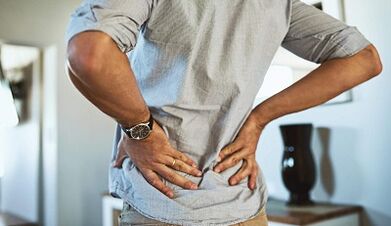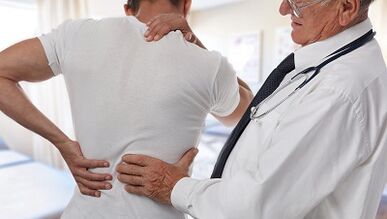
Back pain can occur at any age, but most often occurs between 35 and 55 years.Pain in the spine is associated with how our bones, muscles, intervertebral discs, ligaments, tendons and nerves work.
Pain in the spine can be caused by problems with vertebrae, discs between them, ligaments around the spine and discs, spinal cord and nerves, back muscles, internal organs in abdominal and pelvic areas.In addition, aorta diseases, the tumors in the chest and the inflammation of the spine in the upper back can be the cause of the pain in the upper back.
Risk factors
The presence of risk factors increases the probability of developing a state.For example, obesity considerably increases the risk of diabetes of the second type.
The following factors are associated with an increase in the risk of back pain.
- office work;
- work associated with a constant constraint;
- Pregnancy - Pregnant women often suffer from pain in the spine;
- sedentary lifestyle;
- age;
- depression;
- obesity / excess weight;
- smoking;
- heavy physical exercises;
- heavy physical work.
Signs and symptoms of back pain
The symptom is what the patient feels, while the doctor can notice the sign.For example, pain is a symptom, while rash is a sign.
The main symptom of pain in the spine is pain in any part of the back.Sometimes the pain extends to buttocks and legs or shoulder and arms.
You should immediately contact your doctor if the pain in the spine accompanies one of the following signs:
- weight loss;
- High temperature (fever);
- Back pain is not relieved after rest;
- painful pain;
- Pain lowering under the knee;
- the presence of fresh spine lesions;
- Urine incontinence (even a small portion);
- Difficulties with urination - urine is difficult;
- Fécale incontinence - Loss of control over the defecation process;
- numbness in the area of the genitals;
- numbness in the anus;
- Numbness in the buttocks.

Ask for the advice of a specialist if you are one of these groups:
- people under 22 or over 55;
- Patients who have taken steroids for several months;
- cancer patients;
- Patients who had cancer once;
- Patients with low immunity.
The causes of back pain
The human spine is a complex structure made up of muscles, ligaments, tendons, discs and bones.The intervertebral discs are located between each pair of vertebrae and operate as friction shock absorbers.Problems with one of these components can cause pain in the spine.In some cases, the causes of pain cannot be established.
Drawing
The most common causes of pain in the spine are:
- Stretched muscles;
- stretched ligaments;
- Raise a heavy object in poor pose;
- raise an too heavy object;
- the result of a net and clumsy movement;
- Muscle spasm.
Structural problems
The following structural problems can cause pain in the spine:
- Protective of the intervertebral disc.The rupture of the external sheath of the disc leads to the bulge of its internal content to the outside.This can lead to pinches of the nerve and, therefore, pain;
- An herniated of the intervertebral disc- stab of the internal content of the large disc;
- sciatica- Acute pain and shot, which radiates towards the buttock and the rear area of the leg caused by the projection or hernia of the intervertebral disc, compressing the nerve;
- arthritis- Patients with osteoarthritis generally feel problems with the thigh joints, lumbar column, knees and hands.In some cases, stenosis of the vertebral canal can occur, because the space around the spinal cord is narrowed;
- Abnormal spine- If the spine folds in an unusual way, the patient is more likely to suffer from pain in the spine.An example of an abnormal turn is scoliosis, in which the spine folds on the side;
- osteoporosis- The bones, including the vertebrae, become fragile and porous, which leads to an increase in their fragility.

Here are some other causes of pain in the spine:
- Ponytail syndrome- The ponytail is a bunch of nerve roots in which the spinal cord is branched.People with ponytail syndrome feel dull pain in the lumbar column and buttocks.There may also be a loss of sensitivity of the buttocks, genitals, thighs.Sometimes people with ponytail syndrome suffer from urinate and / or excrement;
- spine cancer- The tumor located in the spine can tighten the nerve, which causes pain;
- Vertebral column infection- if the patient has a high body temperature and also has a painful hot area on the back, this may indicate the infection of the spine;
- Other infections- inflammation of pelvic organs in women, as well as bladder and kidneys infections can also cause back pain;
- sleep disturbances- people with sleep disorders more often experience pain in the spine compared to the general population;
- shingles- infection that can affect nerves;
- Inappropriate mattress- If the mattress does not support certain parts of the body and does not ensure the uniform position of the back, there is a risk of developing pain in the spine.
In addition, the cause of pain in the spine can be certain body movements or positions, such as prolonged driving, cough, etc.
What to do when the return hurts
If you feel pain in the spine for several days, the following advice will help you reduce pain and discomfort and accelerate recovery:

- Remain active as possible;
- If necessary, use pain relievers -analgesic;
- Use hot and cold compresses.A bottle of hot water and a bag of frozen vegetables will be made.
Despite the fact that it is difficult to remain optimistic when you suffer from pain, try not to lose heart.This will speed up the recovery process.
With prolonged pain in the spine, which does not pass within six weeks, you should consult a doctor.The doctor will compile medical history, will carry out an exam and, if necessary, will direct him to additional studies.The doctor may prescribe an x -ray in the event of a problem suspicion with a bone system or osteoarthritis, TDM (CT scan) or MRI (magnetic resonance tomography) in the event of suspected intervertebral hernia or any other problem with soft tissues or nerves.In such a situation, MRI is the best choice.The doctor can also advise you to hand over certain laboratory tests or measure the electrical activity of the nerves (EMG).
After making a diagnosis, the doctor prescribes treatment.In most cases, there is sufficiently conservative treatment, which may include:
- special exercises;
- reflexology;
- vertebral extension;
- massage.
In serious cases, the question of the operation can be raised.The surgeon will help you choose the appropriate method and also advise you on possible complications.Some time after the operation, the first cycle treatment of the spine is recommended.Remember that the spine operations are quite dangerous, as the operating area is in the immediate vicinity of the nerves.















































